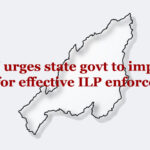India’s Act East Policy, designed to promote economic cooperation, cultural ties, and strategic relationships in Southeast Asia and East Asia, deserves scrutiny for its broader geopolitical objectives beyond the development of the Northeastern Region (NER).
The BJP-led NDA government often touts its role in fostering development in the Northeastern Region through the Act East Policy. During a recent campaign speech in Tripura, Prime Minister Modi even accused the Congress of adopting a ‘Loot East’ policy, which he claimed disparaged the Congress’ original ‘Look East Policy’.
In response, Congress MP Shashi Tharoor challenged this assertion, contending that the ‘Look East policy’ was not a policy about the country. “Look East and Act East are about Southeast Asia, not domestic Indian politics,” remarked Tharoor.
Introduced in 2014, the Act East Policy aims to strengthen economic and strategic ties with nations in Southeast Asia and East Asia. Despite India designating members of the ASEAN bloc, Japan, and South Korea as primary trading partners, it faces trade deficits with each, importing more than exporting.
A recent report by the economic think tank Global Trade Research Initiative (GTRI) analyzed India’s three major Free Trade Agreements (FTAs) with ASEAN, South Korea, and Japan, signed between 2010 and 2011. The report highlighted a significant increase in India’s merchandise trade deficit with these partners compared to its global trade deficit. It also underscored slower growth in India’s exports to these FTA partners compared to its imports.
Regarding South Korea, despite consistent efforts to strengthen bilateral trade relations, India’s exports to South Korea have lagged its imports. According to data from the Ministry of Commerce and Industries, for the calendar year (CY) 2023, India’s exports to South Korea amounted to US$6.286 billion, marking a 16.61 percent decrease annually, while imports from South Korea reached US$21.361 billion, showing a 3.19 percent annual increase.
As per media reports, India aims to secure increased market opportunities in South Korea for key exports, such as rice, steel, and shrimp, as well as for sectors like healthcare and information technology (IT).
Additionally, India and South Korea are set to commence another series of talks to enhance their Comprehensive Economic Partnership Agreement (CEPA) in May-June 2024, following the completion of the 10th round of discussions earlier this year. In the upcoming rounds of discussions, it is reported that India is looking to narrow this trade gap.
At the end of the 2023 G20 summit in New Delhi, India and South Korea signed agreements to cooperate in supply chains, military industries, and space exploration.
Meanwhile, with Japan, according to data from the Commerce Ministry, India’s imports totaled US$17.506 billion in CY23, while exports amounted to US$5.084 billion. Since 2010-11, Japan’s exports to India have doubled from US$8.62 billion, whereas India’s exports to Japan have remained relatively stagnant. Media reports have suggested a likelihood of India revisiting its 2011 FTA with Japan in May, aiming to mitigate the trade imbalance with Tokyo.
With ASEAN countries, bilateral trade between India and ASEAN amounted to US$131.5 billion in 2022-23, representing 11.3 percent of India’s global trade during that period. During the 20th ASEAN-India Economic Ministers’ meeting on August 21, 2023, in Semarang, Indonesia, ministers from member countries assessed the bilateral trade and investment ties between India and ASEAN. They agreed to work towards strengthening this economic partnership to yield significant advantages for both parties.
Southeast Asia and East Asia represent some of the world’s fastest-growing regions, offering highly favorable environments for manufacturing, transporting, and sourcing completed goods. This positions them as indispensable players in the global economy. Now, New Delhi seeks to establish commercial and trade engagement with these regions on more equitable terms. It aims to prevent the misuse of its FTAs with these countries by third parties like China and to secure greater market access to bolster its export-oriented industries.
(With inputs from India Briefing)



